Revised March 7, 2016
I have been studying taxonomy of cichlid fishes from Lake Tanganyika. I hereby introduce taxonomic species that I have described.
Xenotilapia rotundiventralis
Haplotaxodon trifasciatus
Cyprichromis zonatus
Cyprichromis coloratus
Cyphotilapia gibberosa
Benthochromis horii
Petrochromis horii
Xenotilapia rotundiventralis (Takahashi, Yanagisawa and Nakaya, 1997) FishBase
Cichlidae; Pseudocrenilabrinae; Ectodini
|
This species was originaly described as Microdontochromis rotundiventralis.
Xenotilapia includes 17 species, and is the second largest genus after Neolamprologus in the Tanganyikan cichlids.
Most species of Xenotilapia are benthic, but this species usually makes a school in water column.
The species name "rotundiventralis" means "round ventral" in Latin.
It was named from the round outline of ventral fin.
Takahashi T et al. (1997) Ichthyol Res 44:109-117 |
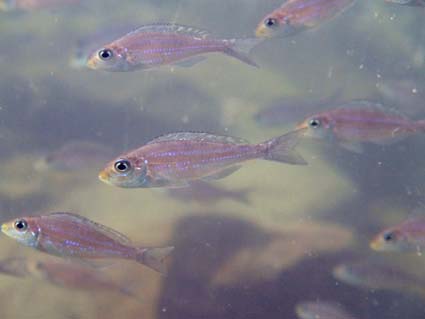 Xenotilapia rotundiventralis Nkumbula Is., Zambia, 2 m depth |
Haplotaxodon trifasciatus Takahashi and Nakaya, 1999 FishBase
Cichlidae; Pseudocrenilabrinae; Perissodini
|
Genus Haplotaxodon constitutes this species and H. microlepis.
At Kasenga of Zambia, I often find pairs of this species that guard their broods about 1-2 m above the rocky bottom.
The species name "trifasciatus" means "three bands."
It was named from the three vertical bands on body sides beneath the dorsal fin base.
These vertical bands are visually clear during young stage, but become dim in large individuals.
The individual in the photograph is young, and the bands are still clear.
The other species of this genus, H. microlepis, has four vertical bands.
Therefore, these two species are easily identified by the number of the bands.
H. trifasciatus is also separable from H. microlepis by higher body and more scales between lateral lines.
Takahashi T and Nakaya K (1999) Copeia 1999:101-106 |
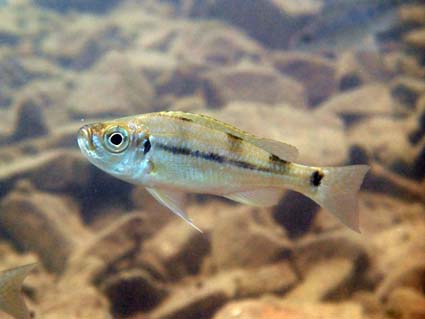 Haplotaxodon trifasciatus Nkumbula Is., Zambia, 3 m depth |
Cyprichromis zonatus Takahashi, Hori and Nakaya, 2002 FishBase
Cichlidae; Pseudocrenilabrinae; Cyprichromini
|
This species was called Cyprichromis sp. 'zebra' (Konings, 1998).
It is characterized by vertical bands on body sides, but these bands are not visible in the individual in the photograph.
These bands disappear immediately after it is caught.
The species name "zonatus" means "band" in Latin.
Takahashi T et al. (2002) Copeia 2002:1029-1036 |
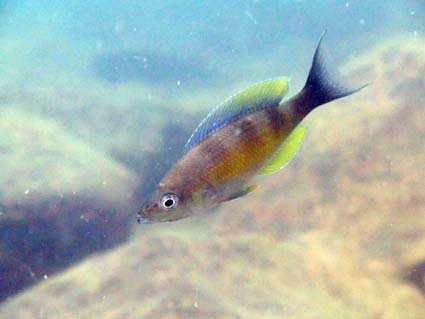 Cyprichromis zonatus Kasenga, Zambia, 6 m depth |
Cyprichromis coloratus Takahashi and Hori, 2006 FishBase
Cichlidae; Pseudocrenilabrinae; Cyprichromini
|
This species is the fish that was traded as "jumbo."
Yellow tail males (upper photograph) and blue tail males (lower photograph) swim together in the same school.
The species name "coloratus" means "coloured."
It was named from colourful body and the existence of two colour morphs in males.
Takahashi T and Hori M (2006) J Fish Biol 68B:174-192 |
.jpg) Cyprichromis coloratus, yellow tail male Nkumbula Is., Zambia, 8 m depth .jpg) Cyprichromis coloratus, blue tail male Nkumbula Is., Zambia, 8 m depth |
Cyphotilapia gibberosa Takahashi and Nakaya, 2003 FishBase
Cichlidae; Pseudocrenilabrinae; Cyphotilapiini
|
Cyphotilapia constitutes this species (upper photograph) and C. frontosa (lower photograph).
These two species were once treated as a single species.
However, clear differences were found between individuals from nothern half and southern half of the lake.
The type specimen of C. frontosa is identical with the fish from northern half and thus the fish from sourthern half was described as a new species "C. gibberosa."
The individual in the upper photograph is young and the hump on the forehead is small.
However, the hump becomes large in adults like C. frontosa in the lower photograph.
The species name "gibberosa" comes from the hump on the forehead.
Takahashi T and Nakaya K (2003) Copeia 2003:824-832 |
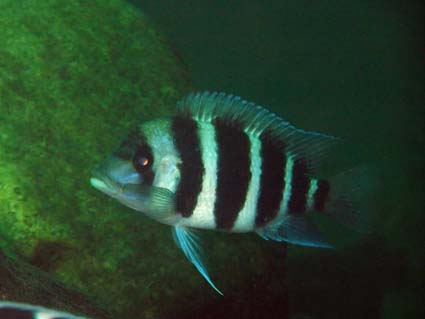 Cyphotilapia gibberosa Kalala, Zambia, 20 m depth 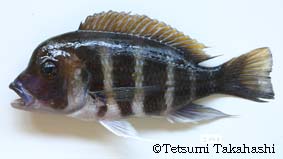 Cyphotilapia frontosa Kigoma, Tanzania, 20 m depth |
Benthochromis horii Takahashi, 2008 FishBase
Cichlidae; Pseudocrenilabrinae; Benthochromini
|
The genus Benthochromis constitutes three species, namely, B. horii (upper photograph), B. tricoti (lower photograph) and B. melanoides.
In some cases, B. tricoti occurs with B. horii off Mtondwe Island, in the southern part of the lake.
Benthochromis horii is characterized by its colour pattern, small eyes, large number of dorsal-fin rays, and some other minor differences.
The species name "horii" is named in honour of Professor Michio Hori of Kyoto University, Japan.
He was the first to identify this fish as an undescribed species.
Takahashi T (2008) J Fish Biol 72:603-613 |
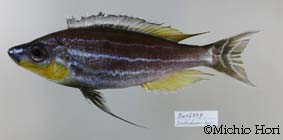 Benthochromis horii 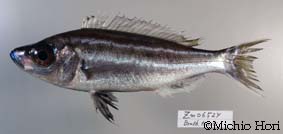 Benthochromis tricoti |
Petrochromis horii Takahashi and Koblmüller, 2014 FishBase
Cichlidae; Pseudocrenilabrinae; Tropheini
|
The genus Petrochrois is composed of species that specialized to eat algae.
This genus includes 7 species and 1 subspecies (this subspecies is sometimes treated as a species).
Petrochromis horii is distinguishable from the other congeners by the position of the mouth and the number of scales on the body side.
Prof. Hori of Kyoto University, Japan found this species as an undescribed species.
So we named this species "horii".
This fish may be identical to Petrochromis sp. "flame tail", which is traded as a ornamental fish.
Takahashi T and Koblmüller S (2014) Ichthyol Res 61:252-264 |
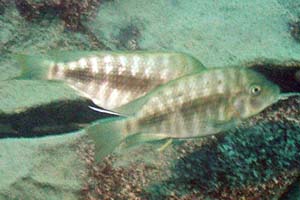 Petrochromis horii |
Home